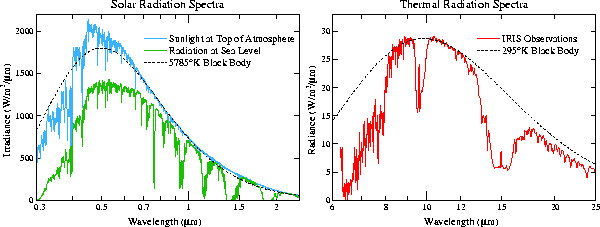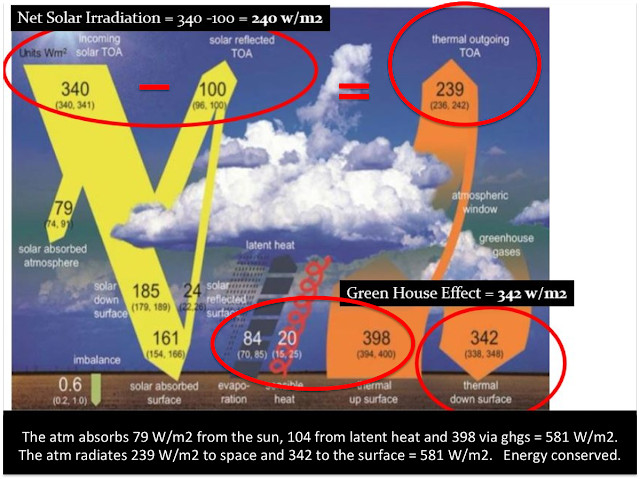
The Foote Effect
August 12, 2019
Some time ago, being defined as about nine years, in his sorely missed Climate Abyss, John Niesen Gammon advocated doing away with the term greenhouse effect, or greenhouse gas, perhaps tongue in cheek, perhaps not
Before we go on, it is probably worthwhile pointing out that what Tyndall found was the absorption of Tyndall gases in the IR at longer wavelengths than 3 microns or so shown in red below
Recently, maybe a year ago, an 1856 report by Edith Foote to the AAAS national meeting has come to light in which she observed the heating effect of sunlight (shown by the blue line in the figure to the left above) on various gases including CO2 and water vapor in a sealed glass tube. Eli pointed out that since the glass tube cut off the solar spectrum (which is relatively weak there) at about 3 microns, Foote did not observe the basis of the greenhouse effect Tyndall gas effect, which is the absorption of thermal radiation from the surface (shown by the dotted line in the figure to the right).
What she did observe is the absorption by water vapor and carbon dioxide shown in green by the bands above 0.7 microns, and maybe down to about 0.3 which are primarily due to aerosol scattering. Since she did experiments with water and thus water vapor in her glass cells, this would not be unlikely.
This absorption, the difference between the blue and green lines above 0.3 microns, has an important practical significance: It is responsible for the absorption of approximately 79 W/m2 in the atmosphere and should a bunny care to include it the 100 W/m2 scattered back into space
Nielsen-Gammon pointed out that there is a long tradition, which he was following, of naming an effect after its discoverer.
Thus the absorption and scattering of visible and near IR light in the atmosphere should henceforth be known as the Foote Effect or the Foote Gas Effect
Okay, I’m finally convinced.Now Eli thinks it was more to having to deal with sniping from the stands, but, be that as it may, John had a suggestion
I hereby declare the greenhouse effect to be nonexistent.
There’s not much worse for public knowledge of science than an important but complex phenomenon whose very name evokes a false analogy. Such is the case with the greenhouse effect.
Naturally, we know lots more about such gases now, including the importance of the wide range of temperature, pressure, and density conditions that accompany their presence in the atmosphere. But Tyndall was the first, and so the “effect formerly known as greenhouse” can properly be called the “Tyndall effect”.John kept it up for quite a while, as Eli recalls until he left the building down at the Houston Chronicle.
But that name is already taken. It refers to the wavelength dependence of light scattering by tiny (sub-micron) particles suspended in an otherwise transparent medium. So that won’t do. Using the same term for two different phenomena would be, I don’t know, like using the term “greenhouse effect” to refer to what keeps greenhouses warm and at the same time use it to refer to what keeps the Earth warm. And wouldn’t that be stupid?
But, not to fear, there’s nothing in science that’s presently known as a “Tyndall gas“. So this term can immediately replace the term “greenhouse gas” to refer to gases that are much more opaque to infrared wavelengths than to visible wavelengths.
A replacement for the term “greenhouse gas” is especially useful since only a small fraction of the gases that fill greenhouses are greenhouse gases. This makes “greenhouse gas” a double misnomer. Wow.
And then, the EFKAG can be renamed more transparently (sorry) as the Tyndall gas effect.
So be it. Henceforth I shall use the terms “Tyndall gas” and “Tyndall gas effect” whenever the opportunity presents itself, or at least until such time as a suitable alternative name comes into broader usage.
Before we go on, it is probably worthwhile pointing out that what Tyndall found was the absorption of Tyndall gases in the IR at longer wavelengths than 3 microns or so shown in red below
What she did observe is the absorption by water vapor and carbon dioxide shown in green by the bands above 0.7 microns, and maybe down to about 0.3 which are primarily due to aerosol scattering. Since she did experiments with water and thus water vapor in her glass cells, this would not be unlikely.
This absorption, the difference between the blue and green lines above 0.3 microns, has an important practical significance: It is responsible for the absorption of approximately 79 W/m2 in the atmosphere and should a bunny care to include it the 100 W/m2 scattered back into space
Thus the absorption and scattering of visible and near IR light in the atmosphere should henceforth be known as the Foote Effect or the Foote Gas Effect



